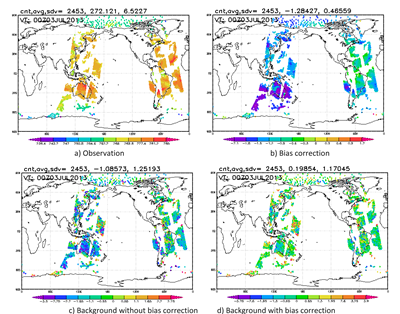Observing System Simulation Experiments (OSSEs)

SSMIS F18 observations, bias, and backgorund with/without the bias correction for July 3, 2013
© JCSDA
by Kayo Ide
The Joint Center for Satellite Data Assimilation (JCSDA) improves and accelerates the use of research and operational satellite data in numerical weather and climate prediction models. JCSDA provides a focal point for the development of common models and infrastructure among NASA, NOAA and DoD.
Observing System Simulation Experiments (OSSEs) provide a rigorous, cost-effective approach to evaluate the impact of the new (envisioned) observing systems and alternate deployment strategy for the existing systems, by the assimilation of synthetic observations drawn from a realistic model simulation, called a nature run (NR), into a data assimilation system (DAS). OSSEs can be also used to evaluate DAS. A clear advantage of OSSEs over any real observing system experiments (OSEs) is the availability of the NR as the truth.
Under a separate project, the JCSDA has recently proposed to develop a comprehensive OSSE framework with a focus on the assessment of geo hyperspectral and radio occultation missions. As a part of this project, the NOAA GFS hybrid DAS will be ported into the O2R environment on JCSDA/NASA Linux cluster JIBB. Once validated and tested carefully, this OSSE framework will serve as a platform to conduct various types of OSSEs.
Geo microwave sensor is an envisioned observing system that can potentially improve NOAA’s forecast skill for severe weather events, especially over the oceans where observations are sparse. Advanced Microwave Sounding Unit (AMSU) observations from polar orbiting satellites have contributed to the improvement of weather and severe storm prediction even with the limited refresh rate. The geo microwave sensor with high refresh rate may contribute to the improvement further by providing better time-evolving information that can be useful in the 4D hybrid DAS. OSSEs will be a perfect platform to assess the potential impact of the geo microwave sensor.
The CICS-MD OSSE Project led by Kayo Ide is currently using the operational 3D-hybrid data assimilation system in two different ways:
i) Observing System Experiments (OSEs) using real observations, to investigate the impact of hyperspectral IR sensors (IAS, CR, CrIS, and AIRS); and
ii) Observing System Simulation Experiments (OSSEs) using simulated observations, to investigate the impact of the geostationary microwave observations.
Current 3D-hybrid setting is T670 deterministic and 80-member T254 ensemble Kalman filter.
All the results are preliminary and shown as example of the progress because the project is just starting and the postdoctoral fellow with her background in satellite observations and but not data assimilation is learning the operational system.
The current OSE is set up for one week, 20130701-20130708. The figure at the top shows the SSMIS F18 observations and the assimilated results with and without bias correction for July 3, 2013 and for the 183.31 GHz channel.
Planned Work:
-
Coordinate with the other JCSDA project, while providing additional support on the building of the OSSE framework.
-
Simulate and validate the observations for a geo microwave sensors.
-
Conduct baseline OSSEs of the observations for a geo microwave sensors and assess the potential impact.
-
Lay out the guideline for the prioritization of the observing systems based on the assessment of their potential impacts.
-
Coordinate with the other JCSDA project, while providing additional support on the building of the OSSE framework.
-
Summarize the OSSE impact assessment.
-
Document and publish the results.
« Back